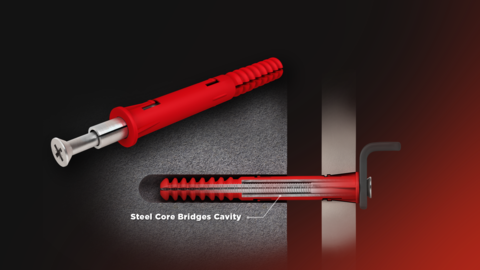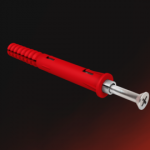Searching for Secure Cavity Wall Fixings? Corefix has the answers
What is a cavity wall fixing?
A cavity wall fixing is a method of attaching or supporting something to a wall when the wall is hollow, or has a space behind it. Unlike older walls which are traditionally solid, most modern houses constructed from the 1930s onwards are built with cavity walls, where there is a small gap between the brickwork and plasterboard. These types of walls are also called dot and dab walls because of the dabs of adhesive commonly used to secure the plasterboard. Securing items to these types of walls therefore requires a strong and reliable cavity wall fixing to protect both your wall and the item you wish to attach. Finding the right cavity wall fixing is essential to reduce the risk of damaging the wall, and appropriately supporting the weight of the fixed item so it doesn’t become loose, or fall away from the wall.
When to use a cavity wall fixing
You should use a cavity wall fixing for any hollow wall. At Corefix, our cavity wall fixings are specifically designed to secure heavy items (Note: you may wish to use more than one fixing for extra security with some larger items) our safe working load is 90kg based on four fixings being used and that is over 3 times the weight of most 50 inch TVS!
The Corefix plasterboard wall fixing has been independently tested so that you can be assured that it will give you a secure, reliable hollow wall fixing which won’t damage your wall – if applied correctly of course!
Corefix – Specially Designed to Support Heavy Loads on ‘Hollow’ Walls
The design of the Corefix cavity wall fixing means that it anchors the load to the wall behind the plasterboard, rather than simply relying on the strength of the plasterboard. This makes it an appropriate wall fixing for other types of wall too such as brick, block and light-weight concrete.
Corefix includes corrosion resistant metal plated steel core and screw and the patented plug has been designed with anti-rotation supports and a serrated angle to ensure the fixing is secured. Other cavity wall fixings typically use only the plasterboard to support the weight of the attached items. This can be much less reliable and cause the plasterboard to lose its shape and distort under the pressure of the weight. Since plasterboard is thin and comparatively weak, some items secured into the plasterboard will be too heavy, pulling the screw out of the wall.
Corefix cavity wall fixings were initially designed for securing kitchen cabinets but they can equally secure TVs, boilers, and heavy duty shelving and have been tested to over 250kg without failure.
Safely Installing a Cavity Wall Fixing – Corefix it!
Using this cavity wall fixing is a simple process that doesn’t require any specialist equipment. You only need a 10mm masonry drill, a screwdriver and a hammer. The whole process can be completed in under a minute.
- Check for wires and pipes. Wires are usually found near plug sockets and switches, often moving vertically or horizontally from these sources. The easiest way to check for wires and pipes is to use a detector, available from most hardware stores. If in doubt, don’t carry on any further.
- Drill through the plasterboard into the wall behind, ensuring a depth of at least 100mm and remove any subsequent dust which may get in the way of the fixing.
- Tap the Corefix plug in place, making sure the lip (flange) sits flat against the plasterboard wall.
- Tap the steel core home until it is level with the plug.
- Use the included screw to secure your wall support.
Cavity wall fixings are easy to install, but it is essential to select the correct product for your wall and the item you are securing. So avoid the common DIY disasters like warped plasterboard, damaged walls and smashed products that have fallen of failed fixings and instead choose a high quality, reliable and proven cavity wall fixing – Corefix it!
Please contact us if you have any questions at all.


